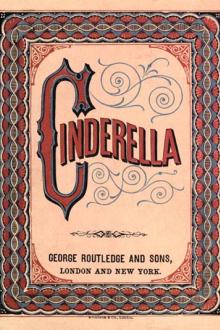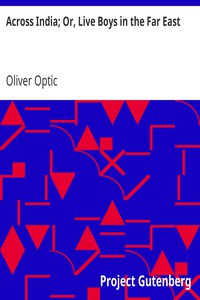Four Young Explorers; Or, Sight-Seeing in the Tropics by Oliver Optic (e book reader for pc TXT) 📕

Read free book «Four Young Explorers; Or, Sight-Seeing in the Tropics by Oliver Optic (e book reader for pc TXT) 📕» - read online or download for free at americanlibrarybooks.com
- Author: Oliver Optic
Read book online «Four Young Explorers; Or, Sight-Seeing in the Tropics by Oliver Optic (e book reader for pc TXT) 📕». Author - Oliver Optic
"The diseases most dreaded in these islands are consumption, dysentery, and anæmia"[254]—
"Mercy, Professor!" cried Mr. Woolridge.
"The reduction in the amount of blood in the system, and the condition resulting from this loss, is anæmia. Dr. Hawkes can explain it more fully," replied the professor.
"Not necessary," added the surgeon.
"As all over the Eastern Archipelago, there are two seasons, the wet and the dry, produced by the monsoons; but the irregularity of the surface variously modifies the result. For the southern and western sides of the mountains the south-west monsoons give the wet season, and the north-east the dry season, and vice versa. Manila is subjected by the influence of the south-west winds to rains from June to November, with dry weather the rest of the year.
"The temperature is about the same all the year round. The coolest month is December, when the glass stays at about 77°; and in May, the hottest month, at 86°. Of course there are days, and times of day, when the temperature is lower than the one, and higher than the other. The extremes where we are going vary only about 25°—from 66° to 91°; and we have it hotter than the last in New York. The average rainfall is about seventy inches, varying by months from one-third of an inch in March, to twenty inches in August.
"The flora of the islands is just what you would expect in this climate. Nearly or quite all the plants you have found in the other islands you[255] have visited are to be found here. Particularly plenteous here are the fibrous plants, and abaca forms in its prepared state one of the most important exports of the islands. This is a sort of plantain from which comes the Manila hemp, as it is sometimes called, though it is a misnomer; and with us it is called simply manila, the sailors tell me. It is extensively cultivated here, and grows something like the banana.
"The stalks on which the leaves grow are split into long strips, are threshed, combed, washed, and dried, and then they become manila, of which many of the ropes of this ship are made, though hemp makes the better article. The finest fibres are sometimes fifteen feet long, and from such some very delicate manufactured goods are produced. The coarser parts are used for cordage, which is very serviceable. When we were at Nassau, in the Island of New Providence, last year, we saw fields of sisal, which has in late years come into use as a substitute for common hemp and manila, and is said to resist the action of sea-water better than any other material.
"The fauna may seem to be quite limited to the Nimrods of our company, for the large animals we have found in other islands do not exist in the Philippines. The buffalo and the gibbon are the largest in the islands, with a variety of monkeys. The elephant, tiger, rhinoceros, bear, and orang-outang have no home here. The only dangerous[256] animals are the crocodile, serpents, and other reptiles. If the Nimrods wish to hunt they will have to try their hand at the wild buffaloes, though they are not to be found near Manila.
"Birds are numerous and various, and especially the gallinaceous bipeds, such as barnyard fowls, grouse, and pheasants; but the most highly valued here is the 'rooster,' if I may call him by his common American name, for cock-fighting is one of the national amusements of Spain and its dependencies. You will see plenty of it in Manila, if you are so disposed; but it is not an elevating sport, any more than bull-fighting, which may possibly prevail here. Coal and iron are the most common minerals, with others; but mining is too severe work for the enterprise of the people, and I believe most of the mines of Cuba are worked by Americans.
"The original inhabitants of the Philippines were doubtless Negritos; and I hasten to explain the name before I am 'picked up.' It was the word used by the Spaniards to designate, not alone the negroes as we find them in Africa, but those who are similar to them. People of this race formerly inhabited all these islands, but there are scarcely any of them left at the present time. Hindus, Malays, and other natives of the adjacent countries and islands, came here, and the races mingled.
"The people found here at the present time have a variety of names, beginning with the pure Spaniards,[257] Creoles, Tagals, Chinese, and Mestizoes. The Spaniards and the Tagals need no explanation, for the latter are the pure natives of the islands. Creole, I believe, is variously used in different locations; but it is a Spanish word, coming from criolla, which means grown up. They are one thing in the Spanish West Indies, another in Brazil.
"A more general definition is a person born in any country, but not of native blood. In the Philippines, Creoles are the children of Spanish fathers and native mothers. Mestizoes are children of Chinese parents on one side and natives on the other. The last class are usually called 'métis' in Manila and elsewhere. You will doubtless see all of these classes, and with a little practice will be able to identify them.
"The Spaniards of the islands are Catholics, often, I am sorry to say, merely nominally such. Many of the natives are Mohammedan, though the greater portion are Catholic. The Philippines were discovered by Magellan, as we generally call him, though that was not his correct name, in 1521. He was born in Portugal, and his name was Magalhães. He served as a soldier in Malacca and Morocco, and was lamed for life in a battle in the latter. He did not think his services were appreciated by his king, and he offered them to Spain.
"He presented to Charles V. a plan for reaching the Moluccas by sailing to the west; and, his scheme being approved, he was fitted out with a fleet of five ships. He passed through the straits south of Pata[258]gonia, which still bear his name, crossed the great ocean, to which he gave the name of Pacific, though it was discovered by Balboa, who called it the South Sea. Succeeding in his enterprise, he reached the Philippines, after putting down a mutiny. He was killed in an expedition he led in the islands. The Victoria, his ship, returned to Spain in charge of one of his subordinates, thus completing the first voyage ever made around the world.
"There were several governments in the islands, and most of them were conquered or conciliated so that they came under Spanish rule; but the Mohammedans of Sulu, the Archipelago north-east of Borneo, and Mindanao retained their independence for a long period, and they still retain their boundaries and government.
"Manila has a population of 270,000, and there are several other considerable towns with 30,000 or more. There is a submarine cable to Hong Kong, 720 miles of telegraph, and 16 miles of railroad out of Manila. The army consists of 4,800 men, with 3,500 gendarmerie, or police, such as ride in pairs all over Spain. It has a navy of two corvettes, six avisos, or despatch vessels, sixteen gunboats, with 2,000 sailors and marines. I believe I have told you all that is necessary to know about the Philippine Islands in a general way; and I thank you for your attention through the long talk I have given you," the professor concluded, and retired from the rostrum in the midst of the hearty applause bestowed upon him.[259]
"I think we all know more about the Philippines than we ever knew before, though I have been there; and to-morrow I shall have something to say, very briefly, about the city of Manila," said the commander.
"When shall we get there, Captain?" asked Dr. Hawkes.
"Day after to-morrow morning; but I shall lay off so as not to get there at three in the morning."[1]
[260]
[1] On board of a steamer from Colombo, Ceylon, to London, I met an educated Scotch gentleman from Manila, who pronounced the name Philippine, the last i long. On the steamer from Liverpool to Boston, I met a lady, also from Manila, and she pronounced it with a long i in the last syllable. I conclude this is the fashion among English-speaking people in the Philippine Islands.—O. O.
CHAPTER XXVIII THE DESCRIPTION OF AN EARTHQUAKY CITYIn the afternoon of the second day out Professor Giroud called his pupils together in the library, which was the schoolroom of the ship, and resumed the lessons which had been interrupted since the arrival at Sarawak. The long intermission had sharpened the intellects of the class, and they were very earnest in their studies. But it could be only for the afternoon and the next day, for the commander was very diligent in the business of sight-seeing.
At half-past nine the next forenoon, the passengers were all assembled in Conference Hall, as the captain had appointed; and the siamangs, who spent much of the time aloft running up and down and along the foreyards, were in their usual places, for chairs had been provided for them; and they looked as grave and attentive as though they understood the whole of the lecture. Captain Ringgold appeared on the rostrum, after he had patted Mr. and Mrs. Mingo on the head, and glanced at Miss Mingo in the lap of Miss Blanche.
"Manila is the capital of all the Spanish possessions in the East, as the professor has informed you; it has a population of 270,000, which is 40,000[261] greater than Havana," he began. "It is on the south-west coast of Luzon, 650 miles from Hong-Kong, which is a run of about forty-seven hours for the ship. It is located on both sides of the little river Pasig, which is the outlet of Lake Bahia, or the Lake of the Bay. When I was here many years ago, I spoke Spanish enough to get along; but I shall leave the language now to the professor and Mr. Belgrave, for I forget most of it.
"In going to the city we have to pass through Manila Bay, which is really a sea of itself; and, though it is land-locked, it affords little if any protection for vessels in heavy weather, for it is about thirty miles long from north to south, and twenty-five from east to west. A west or south-west wind rakes it about the same as the ocean.
"The city forms a circle, with a piece of it cut off on the bay; and the suburbs are on several islands in the river and bay. To keep a clear channel, the Pasig is extended into the bay between two piers, with a fort at the end of one, and a lighthouse at the end of the other. The anchorage in the bay is good enough so far as holding ground is concerned, except in the south-west monsoon, when vessels of four hundred tons or more have to go to Cavite, ten miles south south-west from the city; and their cargo must be taken to and from them in lighters.
"The oldest part of Manila is on the southern bank of the Pasig, and is strongly fortified; but it has a dilapidated look, for it was founded in 1571.[262] On the north side of the river is the Binondo suburb, as it is called, which is more populous than the old part. The foreign merchants live here, and it is the more important commercial centre. You would hardly know, if you waked from a sleep there, whether you were in a Spanish or an Oriental city, for you would see something of both. Gloomy-looking churches, awkward towers, and heavily built stone houses are mixed up with pleasant cottages in groves of tropical trees. I believe the people are now inclined to build more of wood than stone on account of the prevalence of earthquakes, which shake down the heavier structures, and crush the occupants under the weight of the material.
"As in Burma and Siam, the cottages I mentioned are built on posts; for the land is sometimes inundated, and the water requires a free passage, or it would do more mischief. In the month of August, nearly two feet of water falls on a level; and it makes bad work in the low places. The streets are wide and not paved; and in the rainy season, with a foot or two of water lying loose around, they become very nearly impassable. The houses are built in Spanish fashion, with a central court-yard. They are generally two stories high; for in an earthquaky country like this, where terra firma becomes terra shaky, the people are not encouraged to erect buildings twenty stories high, as in New York and Chicago.
"An iron suspension bridge connects the old town with Binondo. It was formerly a stone bridge, built[263] more than two hundred years ago, which was thrown down by the earthquake of 1863. A street in the new suburb, called the Escolto, seems to be the Broadway of the city; for





Comments (0)